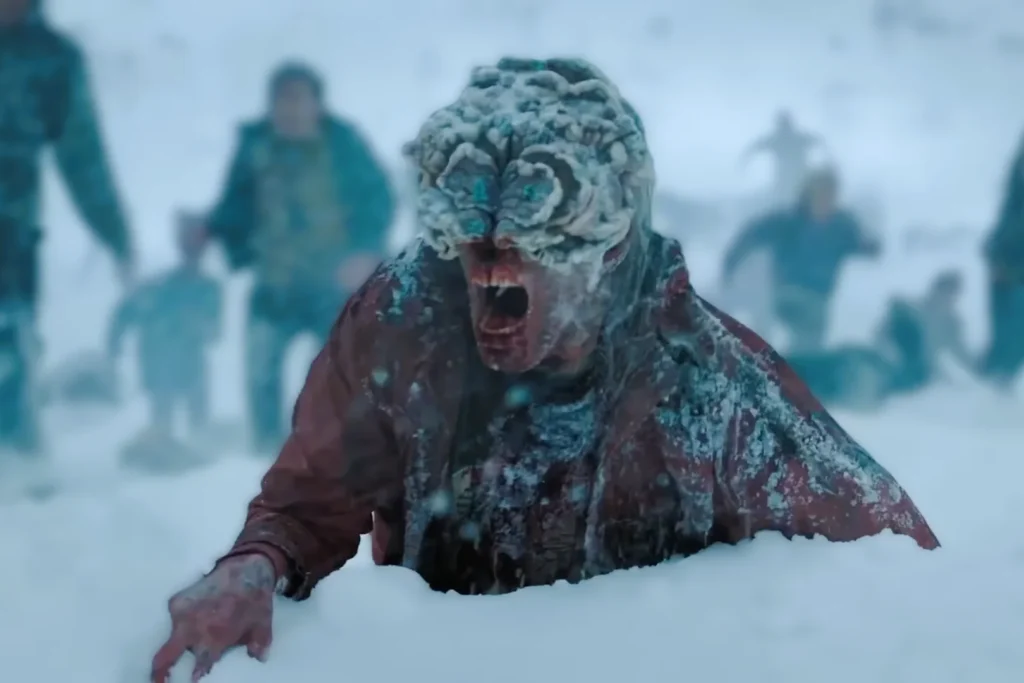Summary
- Robert Eggers reimagines Nosferatu by deepening character motivations, emphasizing Ellen’s internal struggle and agency.
- The ending combines Death and the Maiden visual motifs with Ellen’s duality, showing her as both the source of Orlok’s power and his destruction.
- Ellen’s sacrifice and redemption break the curse, portraying her as a complex, empowered protagonist wrestling with light and darkness.
Robert Eggers’ Nosferatu redefines horror by combining a timeless story with contemporary themes and stunning visuals. This reimagining of F.W. Murnau’s 1922 classic focuses on deeper character motivations, particularly Ellen’s struggle with agency, love, and redemption. The result is a film that is as much about internal battles as it is about external horrors.
Ellen’s Sacrifice in Nosferatu

Ellen’s journey is steeped in complexity. Her act of allowing Count Orlok to feed on her is portrayed as both a redemptive and empowering decision. She acknowledges her role in unleashing Orlok’s evil upon Wisborg, making her final sacrifice a means of restoring balance—not just for the town but for herself.
Unlike earlier versions, Ellen is a character caught between light and darkness. She is no longer a one-dimensional embodiment of purity but a nuanced protagonist wrestling with the consequences of her past actions. This layered characterization makes her sacrifice all the more impactful, transforming her from a victim into a savior.
READ MORE: Desmond Hart’s Thinking Machine Secret in Dune Prophecy
The Climactic Battle Between Ellen and Orlok

The tension reaches its peak when Ellen willingly submits to Orlok in her bedroom, distracting him from the impending dawn. As he feeds on her, their embrace becomes an unsettling mixture of intimacy and horror. This twisted connection is visually represented through the use of Death and the Maiden imagery—a motif from Renaissance art that symbolizes the interplay between love and mortality.
Orlok’s failure to notice the rising sun ultimately leads to his demise. His obsession with Ellen, both as a person and as a symbol of his dark desires, blinds him to his vulnerability. The scene juxtaposes the vampire’s physical destruction with Ellen’s emotional liberation, creating a hauntingly beautiful resolution to their conflict.
READ MORE: Who Rules After Javicco Corrino in Dune Prophecy?
A Story of Redemption and Duality

This duality—Ellen’s internal darkness versus her external heroism—is a recurring theme throughout the film. Unlike her counterparts in earlier adaptations, Ellen is not portrayed as an untouchable symbol of virtue. Instead, she is flawed, relatable, and deeply human, making her ultimate sacrifice all the more poignant.
Eggers’ portrayal of Ellen resonates with contemporary audiences by emphasizing themes of accountability and agency. Her journey is not just about defeating an external monster but about overcoming the darkness within herself.
READ MORE: Imprinting in Dune: How the Sisterhood Controlled the Emperor
Visual Storytelling: Honoring the Original While Innovating

The film features several reimagined iconic scenes, including Orlok’s shadow gliding ominously across Wisborg. This moment, a hallmark of the original, is elevated through modern cinematography, creating a chilling sense of foreboding. The sarcophagus sequence, where Orlok sleeps in dirt from his homeland, is another striking callback that deepens the lore of the vampire.
Eggers’ attention to detail extends to the film’s set design, costumes, and lighting. The climactic embrace between Ellen and Orlok is rendered in stunning chiaroscuro, blending light and shadow to reflect their entwined fates. The use of period-accurate aesthetics enhances the film’s authenticity while reinforcing its timeless themes.
READ MORE: Dune Prophecy Episode 6 Ending Breakdown
Ellen’s Internal Battle: Darkness vs. Light

This internal conflict is explored through Ellen’s dialogue with Orlok. When he claims, “You are not of humankind,” he acknowledges the unique power he sees within her. Ellen’s struggle to reconcile this darkness with her love for Thomas forms the emotional backbone of the film.
Ultimately, Ellen’s sacrifice is not just an act of heroism but a declaration of self-mastery. By choosing to end Orlok’s reign, she reclaims control over her destiny and redeems herself for the chaos her actions once caused.
READ MORE: The Batman Part II Director Addresses Script Delay for Sequel
The Haunting Final Imagery
The film’s conclusion leaves a lasting impression, combining tragedy with triumph. As Ellen dies from blood loss in her bed, cradling the disintegrating remains of Orlok, the visuals convey a bittersweet sense of release.
Eggers uses the shared demise of Ellen and Orlok to symbolize the destruction of their bond. The final shot, featuring their intertwined forms, serves as a metaphor for the duality of life and death, love and sacrifice.
This poignant ending invites viewers to reflect on the cost of redemption and the power of agency. Ellen’s death brings peace to Wisborg and ensures that Orlok’s curse will not continue, but it also underscores the weight of her journey.
Release and Availability
Nosferatu premiered in theaters in late 2024. The film is expected to be available for streaming on major platforms, including Focus Features’ affiliates, by early 2025.
Stay updated with the Latest News and Stories, follow us on our social media platforms.
You can follow us on:
Stay Connected!! Join our Whatsapp Channel















